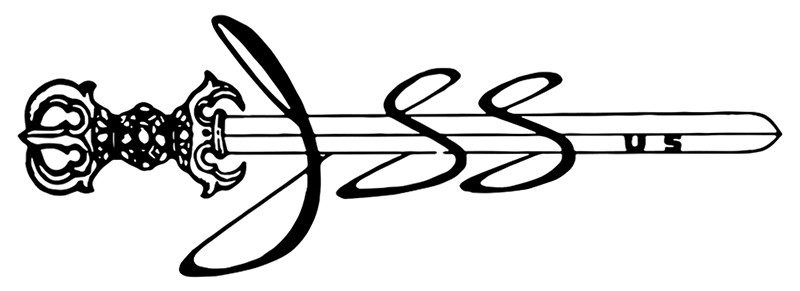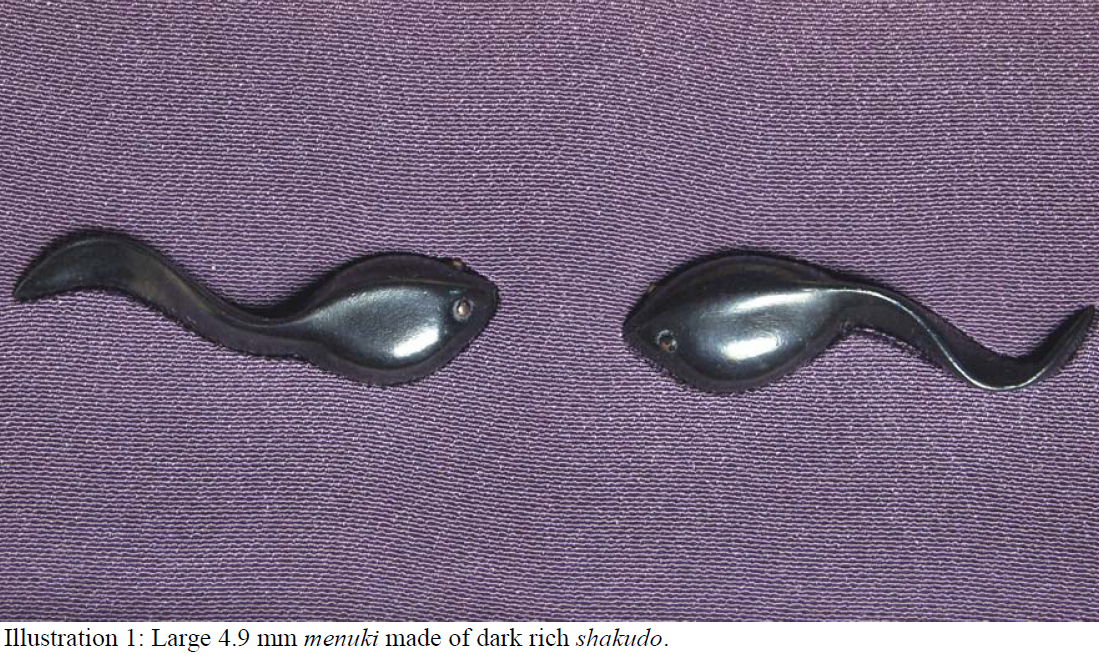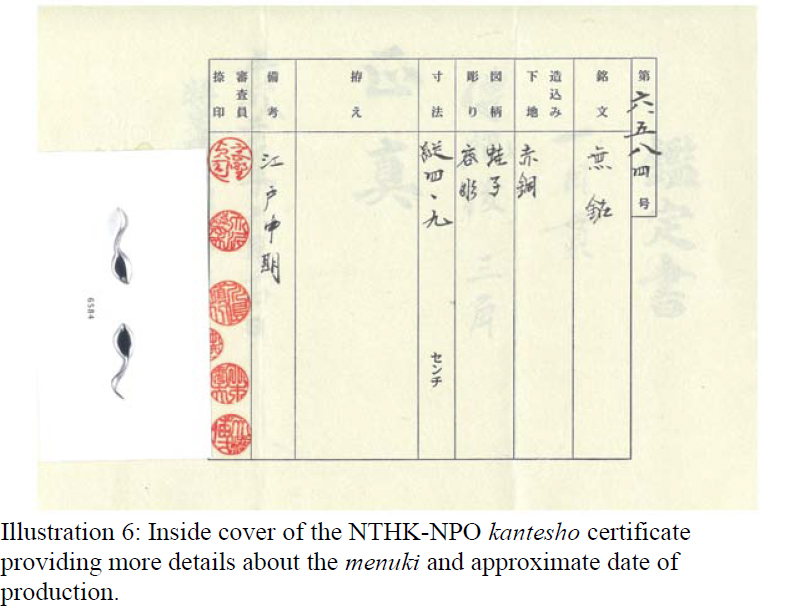
The articles on this page originally appeared in JSSUS newsletter Volume 48 no.3 2016.
Study of Excellence: Misumi Menuki by David Stiles Page 12
Copyright 2016 Japanese Sword Society of the United States
Study of Excellence: Misumi Menuki
by David Stiles
Introduction
In this article I would like to introduce to the readers of the JSSUS newsletter these wonderfullarge hilt ornaments for the Japanese sword (menuki 目貫). This set is an important cornerstone of my collection of Japanese sword fittings. To begin with in this article I will introduce the construction details including the techniques used to construct this menuki set, followed with information about the subject matter and its cultural significance. I will then conclude the article with some historical and biographical information about the maker of this fine set of menuki. The results of their almost year long examination and appraisal in Japan by a panel of knowledgeable expert will also be discussed.
Construction Details
They are made of a dark rich purplish-black copper and gold alloy unique to Japan called (shakudo 赤銅). The rich color alone indicates that the set is made of the high rank of shakudo with a gold percentage upwards of 6-7%.i The surface of each menuki is highly polished (migaki-ji 磨地) in such a way to replicate the wet leather like skin of a real tadpole. This was a very labor intensive process during the Edo Period (1615-1868) before the invention of modern power tools. The tadpole itself is shaped and carved in high relief without a base (katachi-bori 容彫) from a single large flat piece of shakudo. The eyeballs of each tadpole are nicely colored with a subdued bit of gold accent (kin-iroe 金色繪).

The back side of the menuki shows the great amount of shakudo that was used to make each large menuki. Strangely each menuki is finished with a tall triangle shaped support post on the backside. These support posts are added to the back side once the menuki set is completed and are either rectangular or round in shape.

Subject Matter
The design of the menuki is of tadpoles or polliwogs. The term (kaeru-go 蛙子) is used in Japanese with the literal meaning “child of frog”. The design is rendered in a very naturalistic style that clearly conveys the subject's spirit. The considerable motion displayed by long tail of the tadpole is required to convey this spirit.
The cultural significance of the tadpole in Japan is as a symbol of change, metamorphosis, and the Spring season. They are often encountered in springtime in puddles, pounds, or other small bodies of slow moving water.

Historical and Biographical Information
On June 14, 2015 these menuki were directly attributed to be the work of the artist (Misumi 三角) and awarded a written expert appraisal (kanteisho 鑑定書) certificate by the Japanese educational non-profit organization Nihon Token Hozon Kai (日本刀剣保存会) [NTHK-NPO].
The artist worked in Higo Province (肥後國) more specifically near Kumamoto (熊本) Castle
for the Matsui (松井) family who were retainers of the province ruled by the Hosokawa (細川) family. Some earlier references cite Misumi as being contemporary with Hosokawa Sansai (細川三斎) making his working period between 1620 and 1646 of the early Edo Period and located at Yatsushiro Castle before 1632 when the Hosokawa family moved to Kumamoto Castle to rule the entire province of Higo. There is little to no evidence that there was more than one generation of artist using the Misumi name according to research conducted by Itō Mitsuru who put his working period clearly after the time Hosokawa Sansai.ii According to The Index of Japanese Sword Fittings and Associated Artists (ID# H03438.0) the approximate working period for this artist is between 1650 and 1700.iii The NTHK-
NPO agree with this later dating of Misumi working period during the middle Edo Period. Other names used by the artist Misumi are Kōji (幸次), Harunobu (春信), Masaharu (正春), and Okitsugu (興次).

Illustrations 5 and 6 show scans of the kantei-sho certificate issued by the NTHK-NPO. The menuki scored 85 points at the regular monthly shinsa allowing them to be eligible for the year end (yūshu shinsa 優秀審査) held in December.


The menuki passed the yūshu shinsa with a direct attribution to Misumi of Higo Province circa the middle Edo Period. Upon entering this highest level of shinsa the kanteisho certificate was collected and a new yūshu-saku certificate was issued. Later the kanteisho was returned after the completion of the yūshu shinsa. The yūshu-saku certificate of the NTHK-NPO is equivalent to the
NBTHK (jūyo tōsōgu 重要刀装具) certificate. It is only issued to Japanese sword fittings that are of exceptionally fine quality and that are historically important. In regards to the historical importance of this set Itō Mitsuru at the time of publication of his book Works of Hirata & Shimizu there was a total of 26 sets of menuki extant made by Misumi.ii Including this very fine set the total has now increased by one to 27 assuming this set was not included to his original tally. Illustrations 7 and 8 are the outside and inside covers of the NTHK-NPO yūshu-saku paper issued for the menuki.


“Japanese Shakudo Its History, Properties, and Production from Gold-Containing Alloys” by Hachiro Oguchi, Gold Bull., 1983, 16, (4).
Works of Hirata & Shimizu by Itō Mitsuru, translated by Markus Sesko, Copyrighted 2007.
The Index of Japanese Sword Fittings and Associated Artists by Robert E. Haynes, Nihon Art Publishers, Copyrighted 2001.